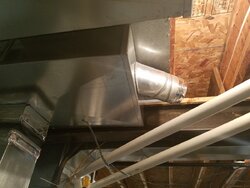I have been using the stove (BK Princess) for about a month now. I am convinced now that the stove needs OAK. Last weekend the stove was out and laundry dryer was going. There was a strong chimney smell at the top of the stairs.
I went downstairs opened the bypass and air, put my hand inside the stove and could feel a strong draft coming down the chimney. To my surprise there was a small piece of charred wood still warm. I did not make anything of it, shut the stove door and left the room. 20 min later I could smell distinctive smoke smell upstairs, went downstairs to see the room hazy with smoke. The little piece of wood started smoldering and due to the dryer running the smoke was being pulled into the room.
Question:
If the OAK was installed, would it prevent this occurrence? And more importantly, why? If the house is supper tight, the dryer or bathroom fan will still pull outside air from somewhere and in this case from the least resistant cavity...the OAK or he chimney. Am I missing something here?
I went downstairs opened the bypass and air, put my hand inside the stove and could feel a strong draft coming down the chimney. To my surprise there was a small piece of charred wood still warm. I did not make anything of it, shut the stove door and left the room. 20 min later I could smell distinctive smoke smell upstairs, went downstairs to see the room hazy with smoke. The little piece of wood started smoldering and due to the dryer running the smoke was being pulled into the room.
Question:
If the OAK was installed, would it prevent this occurrence? And more importantly, why? If the house is supper tight, the dryer or bathroom fan will still pull outside air from somewhere and in this case from the least resistant cavity...the OAK or he chimney. Am I missing something here?


